A Bird’s-Eye View: Olympic Stadiums of Europe from Space
- Zuzana Hajkova, Content Marketing Coordinator, EUSI
The whole world is watching the Olympic Games in Paris with bated breath. But it’s not the first time the Summer Olympics have been held in Europe – 14 stadiums have been built across 10 countries, each of them unique and capturing the spirit of the cities that hosted them. Which one is your favourite?
1896 Athens
This stadium has two names: Panathenaic, which means „for all Athenians“, and Kallimàrmaro, meaning “beautiful marble”. Both names are true. Designed to hold 60,000 spectators (approximately half of Athens’ population in 1896), it’s the only stadium in the world made entirely of marble. Originally constructed in the 4th century BC, the stadium was abandoned for hundreds of years, and then rebuilt to host the first modern Olympic Games.
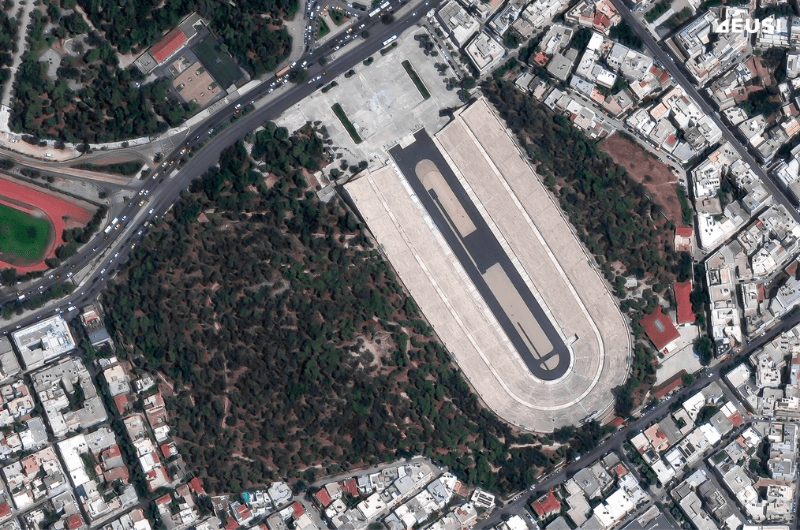
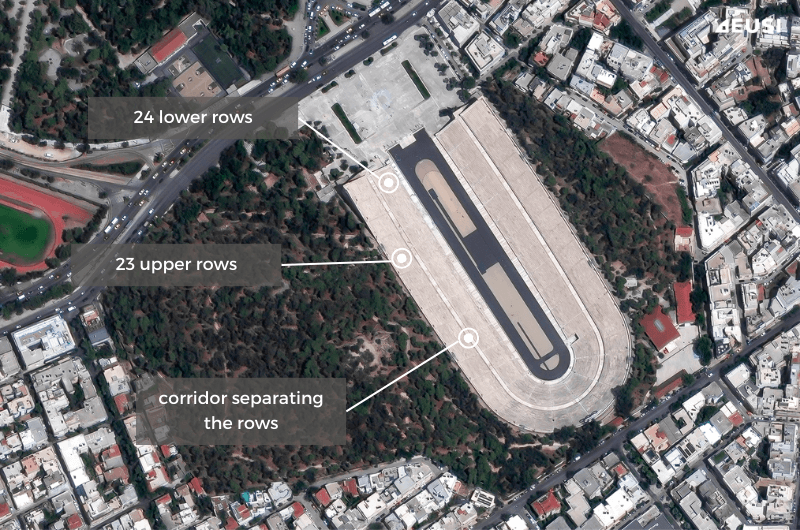
Satellite image collected on 2 July 2024 by Maxar WorldView-3 satellite at 30 cm resolution and 14.6° ONA © 2024 Maxar Technologies Provided by European Space Imaging
1908 London – stadium demolished
In 1907, a stadium of steel and concrete was built in London. It contained not only athletic and cycling tracks, but also a swimming pool with a tower for diving competitions. After the Olympics, it hosted several other major events, however, by the 1980s it was used only for dog races. It was demolished in 1984 to make way for administrative and commercial buildings.
1912 Stockholm
The construction of the Olympic Stadium in Stockholm was accompanied by difficulties. The Organising Committee initially wanted to build only a temporary wooden venue but in the end, they decided to construct a permanent one. The location and construction plans therefore had to be completely changed, and finding the funding was challenging. But the result was well worth it. An architecturally interesting U-shaped stadium was built of stone and brick, using a medieval process typical for fortresses and monasteries in Sweden. The venue is still in use and can host 14,500 spectators.
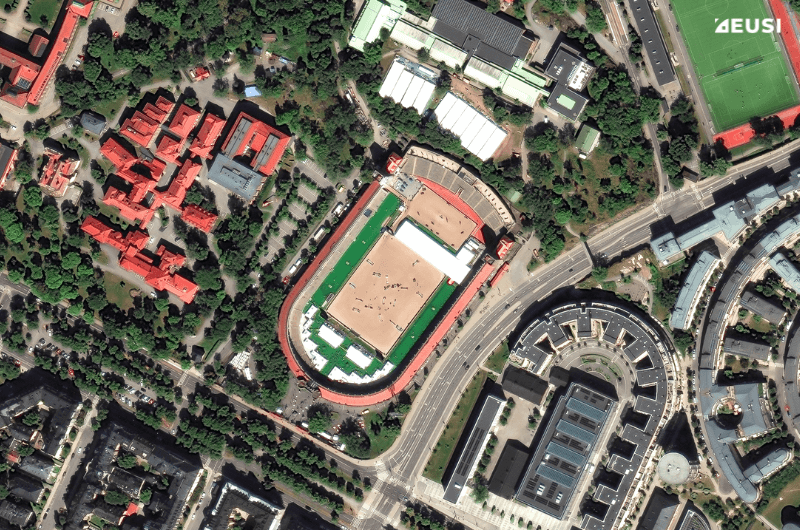
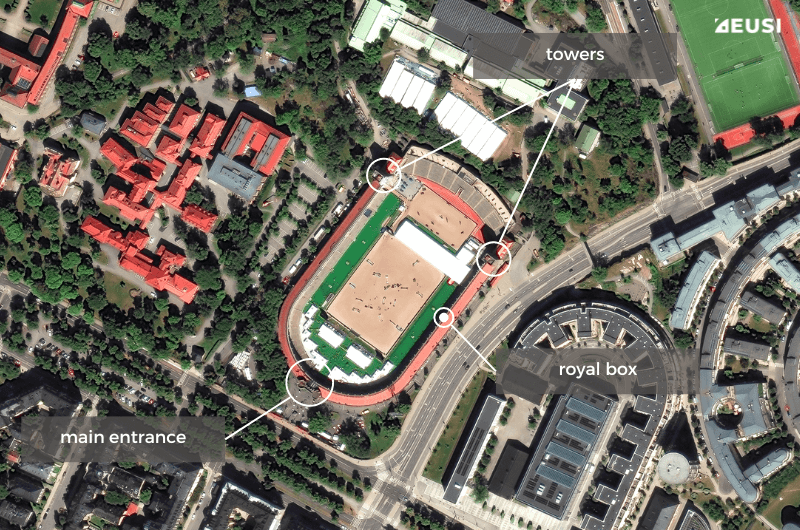
Satellite image collected on 23 May 2024 by Maxar WorldView-2 satellite at 40 cm resolution and 11.2° ONA © 2024 Maxar Technologies Provided by European Space Imaging
1920 Antwerp
A stadium with a capacity of 30,000 spectators was built in post-war Belgium; because of the difficult economic situation, the construction cost double of what was initially expected. The architects were inspired by the stadium in Stockholm – they designed a football field encircled by an athletics track and two main covered stands with a royal box in the centre of one of them. During the reconstruction in 2000, the two stands were replaced by four new ones, and the athletics track was removed.
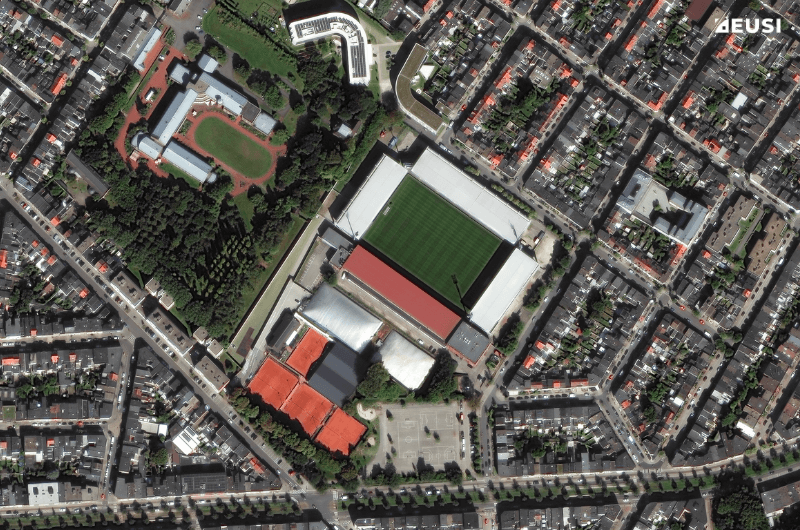
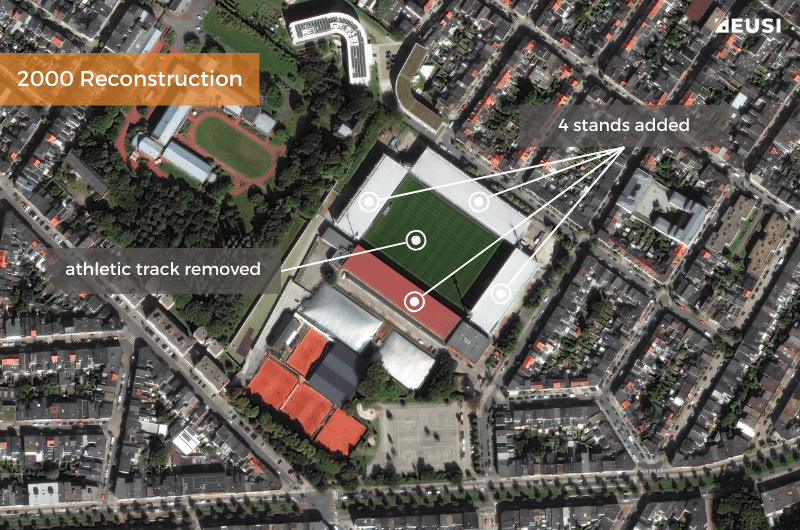
Satellite image collected on 8 September 2023 by Maxar WorldView-3 satellite at 30 cm resolution and 8.7° ONA © 2024 Maxar Technologies Provided by European Space Imaging
1924 Paris
In an effort to spend as little money on hosting the Olympics as possible, an already existing venue – a horseracing track – was rebuilt to become the Olympic Stadium. Its structure was very simple and allowed for a large number of spectators: 10,000 seated and 40,000 standing. While the stadium wasn’t too decorated, it was very modern and included showers with hot water, electric lights, and heating. Now, a hundred years later, the reconstructed venue (Yves du Manoir Stadium) is hosting field hockey at the Olympic Games 2024.
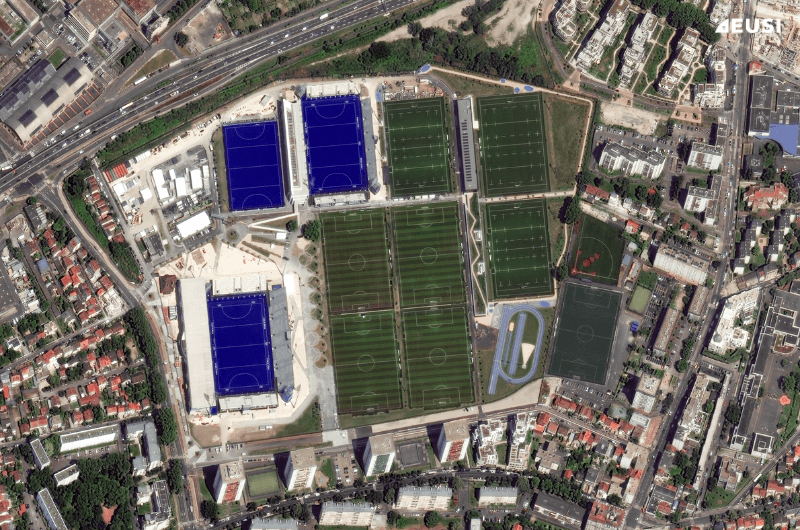
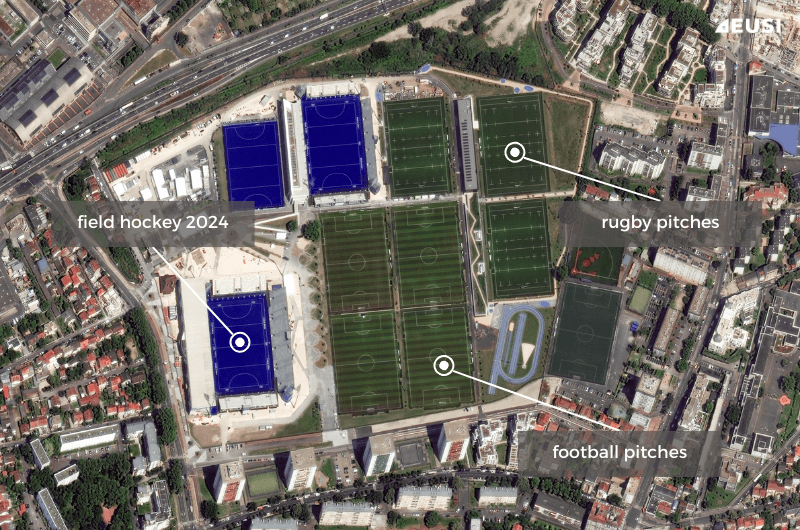
Satellite image collected on 26 June 2024 by Maxar WorldView-3 satellite at 30 cm resolution and 26.1° ONA © 2024 Maxar Technologies Provided by European Space Imaging
1928 Amsterdam
The architect of the Olympic Stadium in Amsterdam thoughtfully designed the structure to work with the elements. The orientation is from north to south to maximise the amount of sunlight and protect people from the wind, and because the venue is surrounded by 30 m wide canals, the land was stabilised by sand and supporting walls were built. In the 1990s, the stadium only narrowly escaped demolition and was completely renovated.
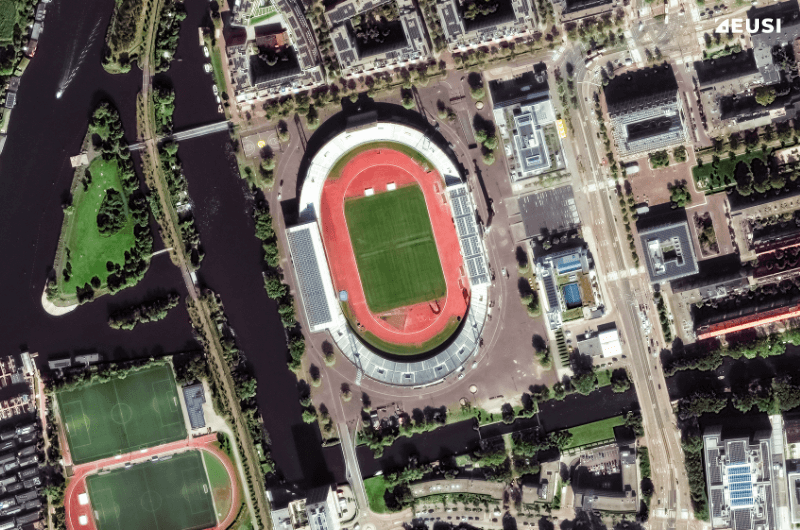
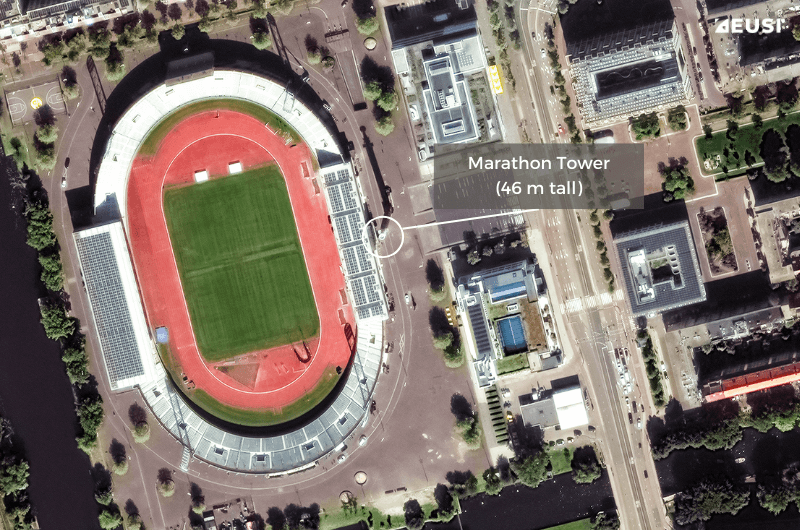
Satellite image collected on 8 September 2023 by Maxar WorldView-3 satellite at 30 cm resolution and 19.6° ONA © 2024 Maxar Technologies Provided by European Space Imaging
1936 Berlin
The Olympiastadion Berlin was built in a neoclassical style with strict symmetry and geometric shapes. It was designed to help the smooth movement of spectators – 100,000 people were supposed to be able to buy tickets and go inside within one hour, which was possible thanks to the large empty area around the stadium and underground passages. In the decades following the Olympic Games, the stadium was reconstructed several times and roofing was added.
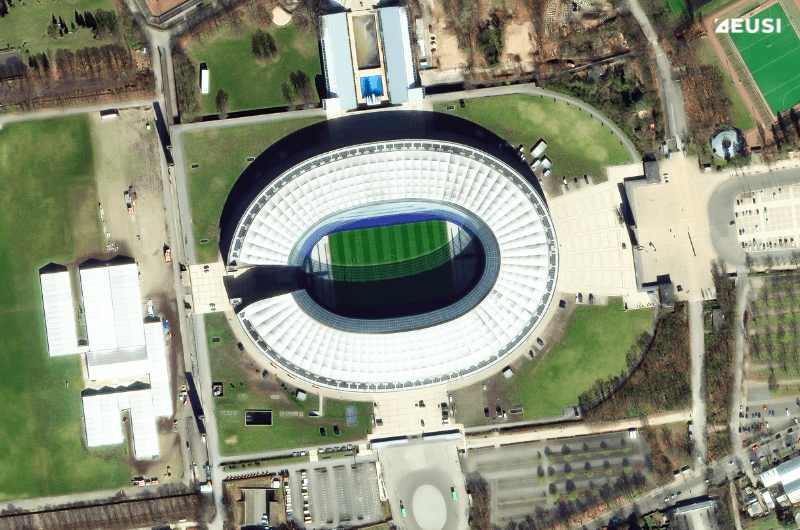
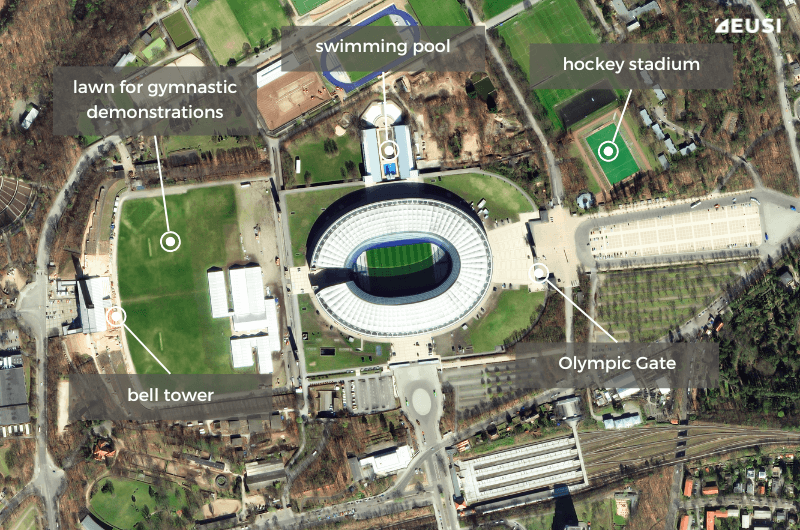
Satellite image collected on 26 March 2024 by Maxar WorldView-3 satellite at 30 cm resolution and 3.5° ONA © 2024 Maxar Technologies Provided by European Space Imaging
1948 London – stadium demolished
When war-struck London held the Summer Olympics in 1948, the city had no funds for building a completely new Olympic venue, and therefore decided to host the event in an already existing one: the Empire Stadium. It was also known as the Twin Towers Stadium, because it included two 38 m high towers. Its capacity was an incredible 100,000 people. Unfortunately, it was demolished in 2003 and a new stadium was built in the same place: the Wembley Stadium.
1952 Helsinki
Finland had wanted to hold the Olympic Games for a long time; they built the stadium in 1927, lost the bid to Berlin in 1936, and when they were finally supposed to host the event in 1940, the Games were called off because of the Second World War. Instead, Helsinki held the Olympics 12 years later, in 1952, and used the stadium built in 1927. Influenced by the functionalist architecture, the venue has concrete walls and ribbon windows. The most noticeable feature is a 72 m high tower, constructed to serve as a landmark for marathon runners. It was the top of this tower where the Olympic flame burnt.
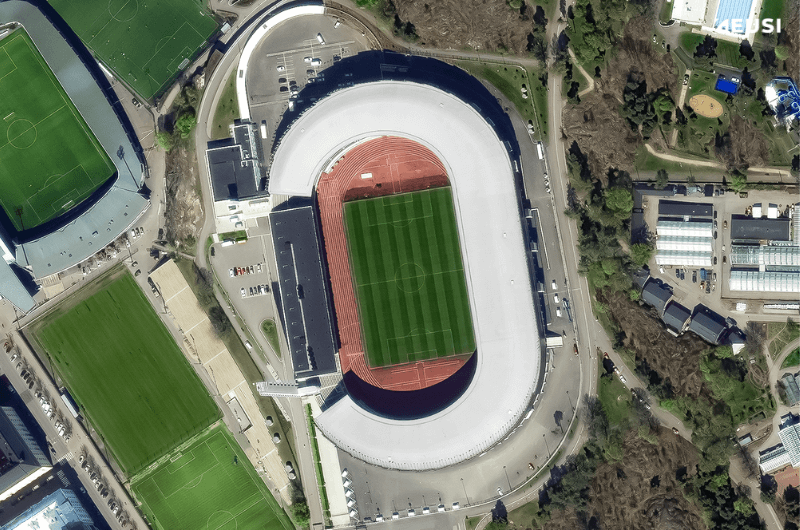
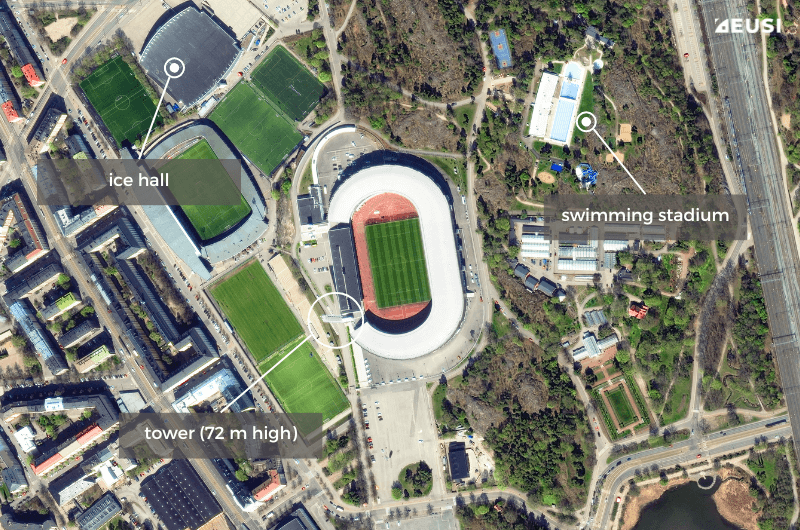
Satellite image collected on 11 May 2023 by Maxar WorldView-3 satellite at 30 cm resolution and 18.8° ONA © 2024 Maxar Technologies Provided by European Space Imaging
1960 Rome
90,000 m2 and 90,000 spectators – that’s Stadio Olimpico in Rome. The designers put a special emphasis on safety and security: a 2 m wide and 1.90 m deep ditch separated the spectator stands from the athletics tracks, and a combination of a drainage system with an underground irrigation system provided the necessary humidity during the hot, dry summer in Rome. Ten gates allowed quick access to the huge number of visitors, and two underground tunnels provided entry to the athletes.
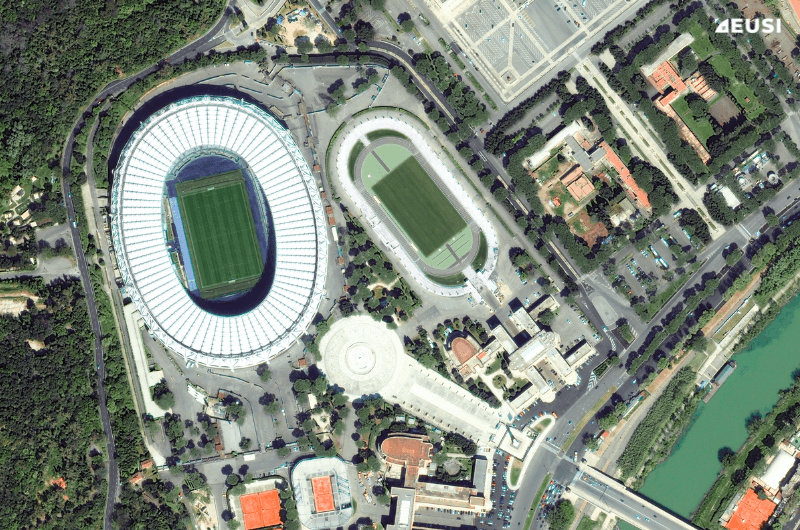
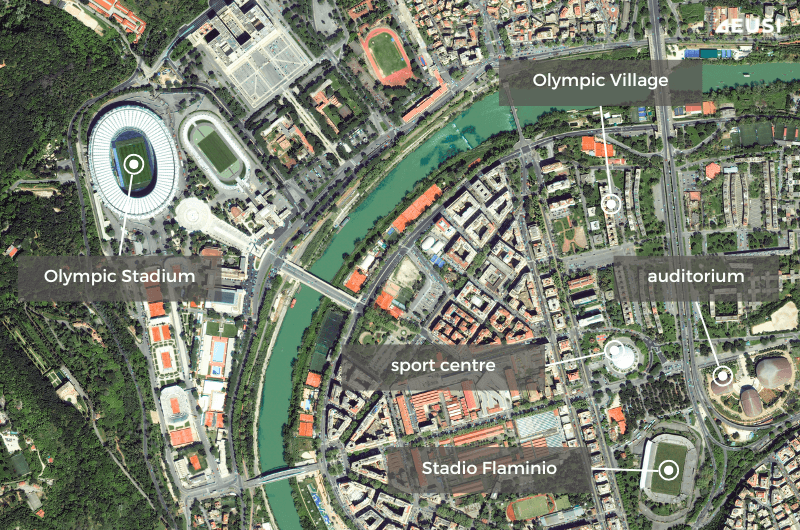
Satellite image collected on 13 April 2024 by Maxar WorldView-3 satellite at 30 cm resolution and 8.3° ONA © 2024 Maxar Technologies Provided by European Space Imaging
1972 Munich
On a 280-hectare plot of empty land, a whole Olympic Park was built to host the Summer Olympics in 1972. The stadium was connected to the multisport hall and swimming pool by a tent-shaped roof made of an innovative material which was fireproof and translucent to minimise the amount of shadow on the field. To not disrupt the scenery of the park, the enormous building was partly set into the ground, which makes the area even more architecturally interesting. Unfortunately, the Games became infamous for a terrorist attack known as the Munich massacre.
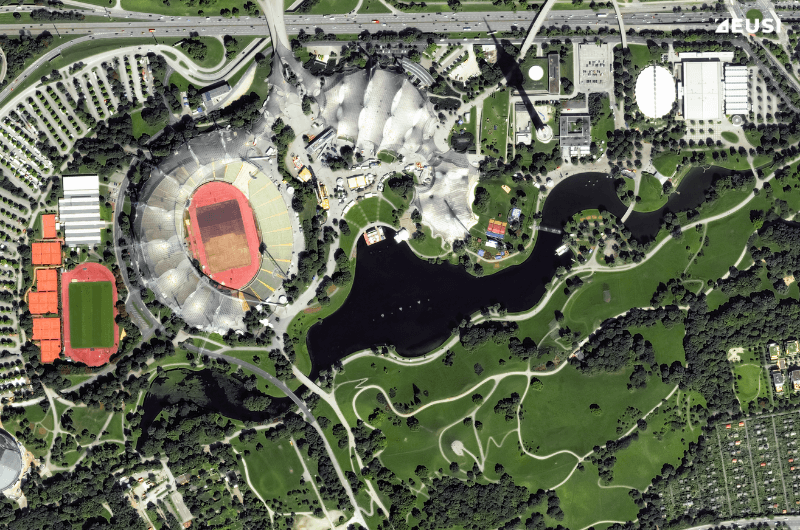
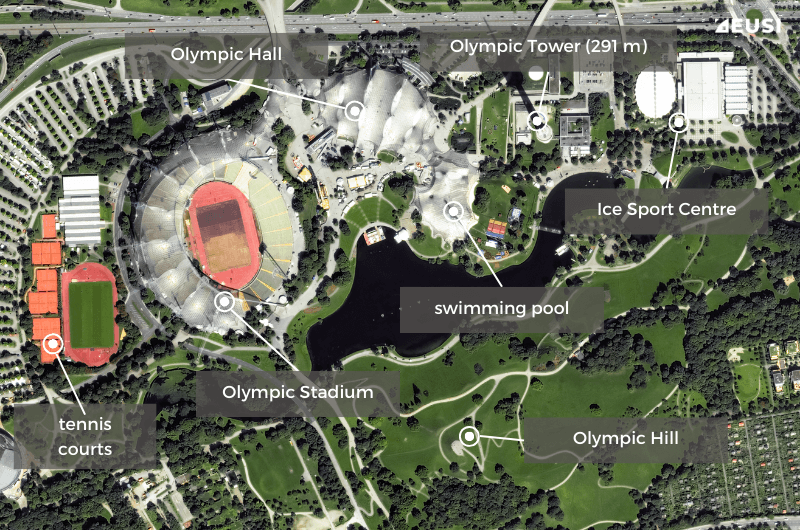
Satellite image collected on 18 August 2023 by Maxar WorldView-3 satellite at 30 cm resolution and 2.5° ONA © 2024 Maxar Technologies Provided by European Space Imaging
1992 Barcelona
The Montjuïc Stadium was built long before holding the Olympics. Because it wasn’t used anymore in the 1970s, there were plans for its demolition but instead, it underwent a complete reconstruction in view of hosting the Games. It’s located on Montjuïc Hill which also includes other important Olympic venues and provides an open space for the crowds.
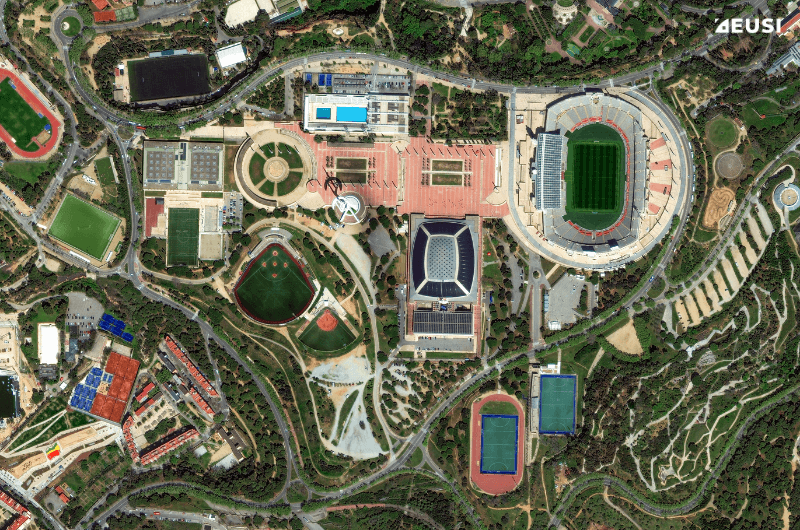
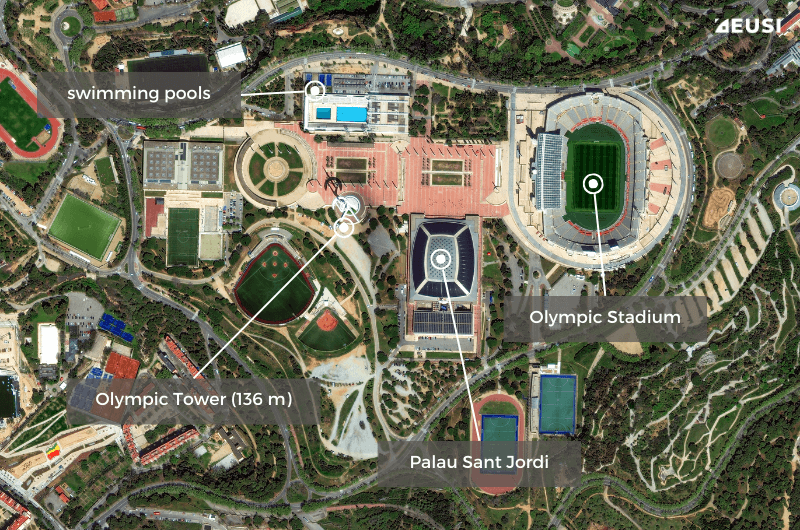
Satellite image collected on 9 April 2024 by Maxar WorldView-3 satellite at 30 cm resolution and 14.8° ONA © 2024 Maxar Technologies Provided by European Space Imaging
2004 Athens
An already existing stadium was chosen to host the 2004 Summer Olympics in Athens. It underwent renovation and was covered with a modern, iconic roof consisting of two curved parts, and designed to withstand earthquakes and strong winds. The OAKA – Olympic Athletic Centre of Athens – surrounds the stadium, including the 250 m long Wall of the Nations sculpture.
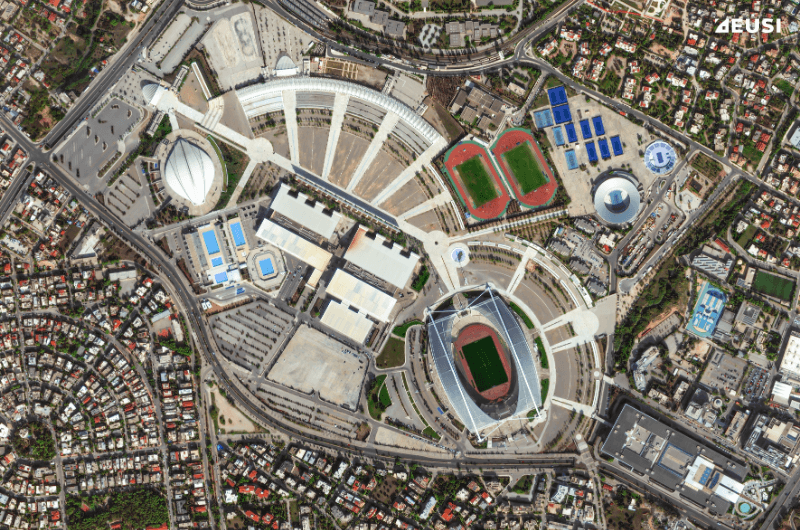
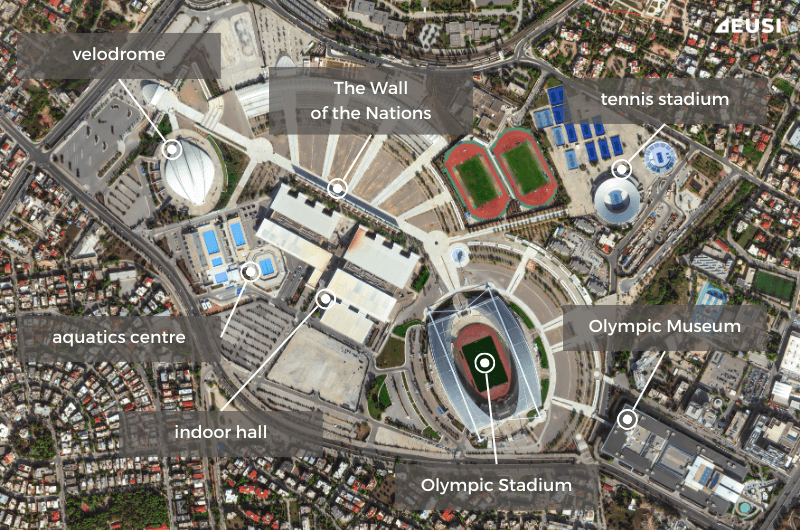
Satellite image collected on 22 October 2022 by Maxar WorldView-3 satellite at 30 cm resolution and 2.7° ONA © 2024 Maxar Technologies Provided by European Space Imaging
2012 London
The 80,000-spectator stadium was built in an industrial zone that the city wanted to regenerate and repurpose. The construction was a huge project: 800,000 tonnes of soil were excavated, 33 old buildings were demolished, and the construction team of 5,250 people used 10,000 tonnes of steel, 5,000 concrete columns, 12 km of ventilation conduits and 338 km of electrical cables. The design was focused on elegance, lightness, and recycled materials.
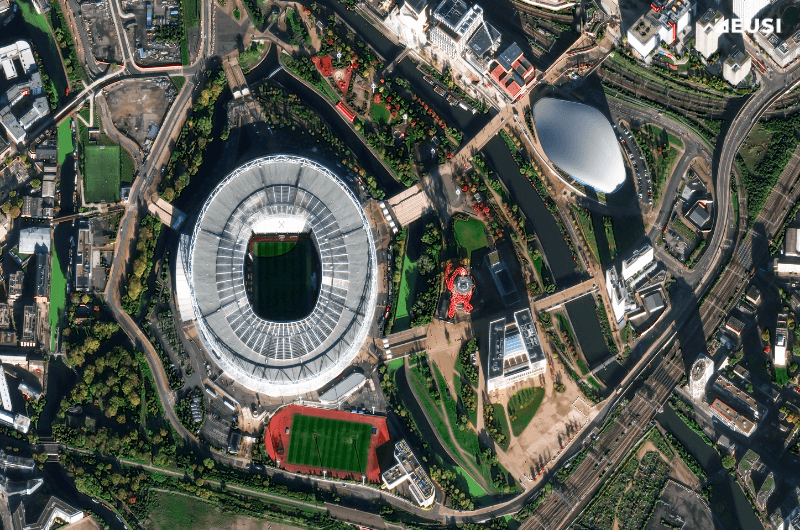
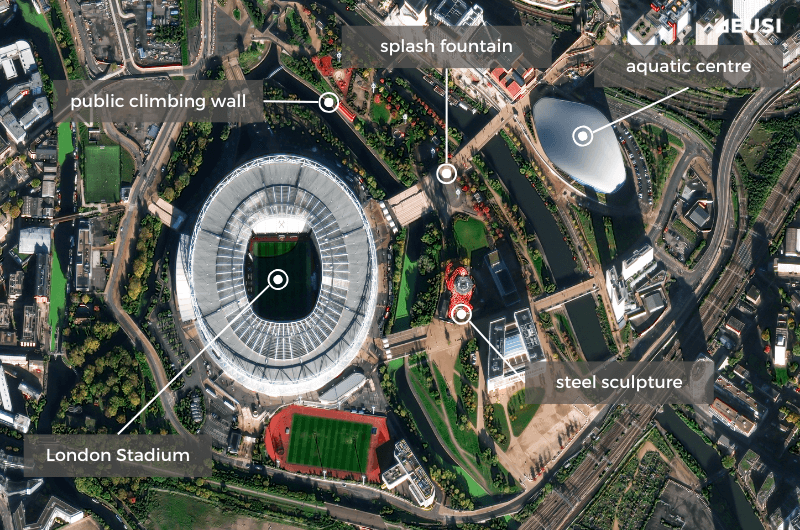
Satellite image collected on 11 November 2023 by Maxar WorldView-3 satellite at 30 cm resolution and 19.7° ONA © 2024 Maxar Technologies Provided by European Space Imaging
Quiz: 5 Test your knowledge of Summer Olympic Stadiums in Europe
- Which city hosted the first modern Olympic Games?
- Which stadium could hold the highest number of spectators?
- This port is located next to one of the stadiums. Which one?
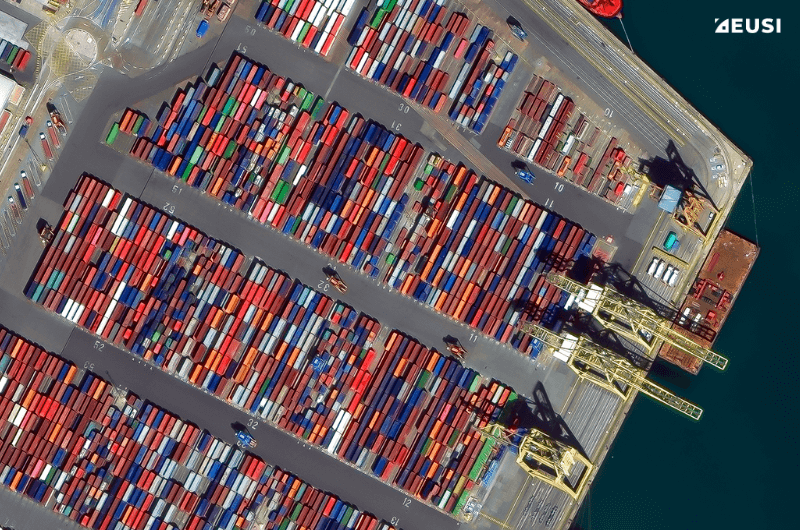
Satellite image © 2024 Maxar Technologies Provided by European Space Imaging
4. Which countries have hosted the Summer Olympics more than once?
5. Which of the stadiums has the highest tower?
Correct answers
- Athens (1984)
- Berlin Olympic Stadium and London Empire Stadium (100,000 spectators)
- Barcelona
- Greece (1896 and 2004), the United Kingdom (1908, 1948 and 2012), Germany (1936 and 1972) and France (1900, 1924 and 2024)
- Munich (291 m)
What next?
Check out our articles on European landmarks or star forts. Or see more information about the Olympic stadiums in the Olympic World Library.
Related Stories
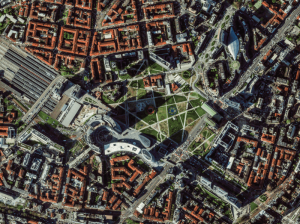
Europe’s Green and Digital Transformations with 25 Years of VHR Satellite Archive Data
Planning Europe’s future without knowing its past is impossible. The European Green Deal, Horizon Europe, the EU Biodiversity Strategy for 2030 and other policies all demand one thing: evidence. Not just today’s data, but years of history that show how our cities, forests, and coastlines have changed.
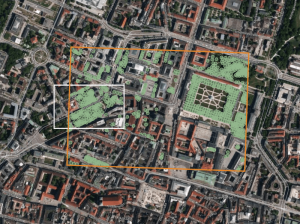
AI Uses 15 cm Satellite Images to Cut Costs and Increase Scalability in Forest Management and Urban Forestry
Forest managers across Europe face an impossible task: monitor millions of hectares with shrinking budgets while meeting increasingly strict EU environmental targets. But with the rise of AI and satellite technology, they now have new solutions at their disposal – smarter, cheaper, and more scalable – to monitor forest health, automate tree inventories, and plan sustainable logging. In this article, we introduce one of these solutions: an AI forestry algorithm developed by Arboair using 15 cm satellite data from EUSI.

GEOSeries: Extracting Insights From High Resolution SAR Imagery for Time-Sensitive Analysis
In this webinar, industry experts and advanced users of Umbra SAR data showcase how they transform SAR imagery into actionable insights in real-world mapping, monitoring and intelligence applications. See how NV5 and Umbra leverage ENVI SAR Essentials for advanced processing with time-efficient results, converting analytics into valuable intelligence.

Using Satellite Imagery to Build Water Resilience Across Europe
Water across Europe is facing severe pressure. Climate change, urbanisation, agricultural demands and other sources of pollution are threatening water security and creating critical challenges that need to be addressed. We have to act quickly, build stronger systems and create sustainable water resilience practices – so that both natural ecosystems and human communities can thrive. Here is how satellite imagery from EUSI can help.





